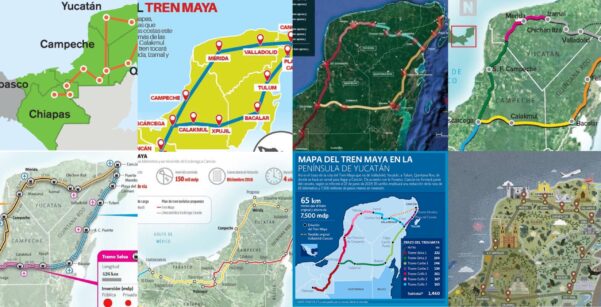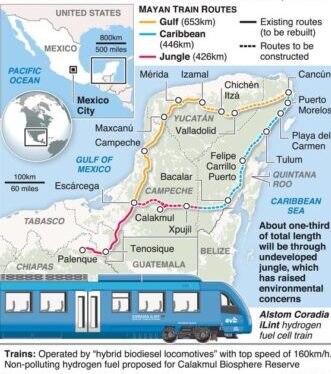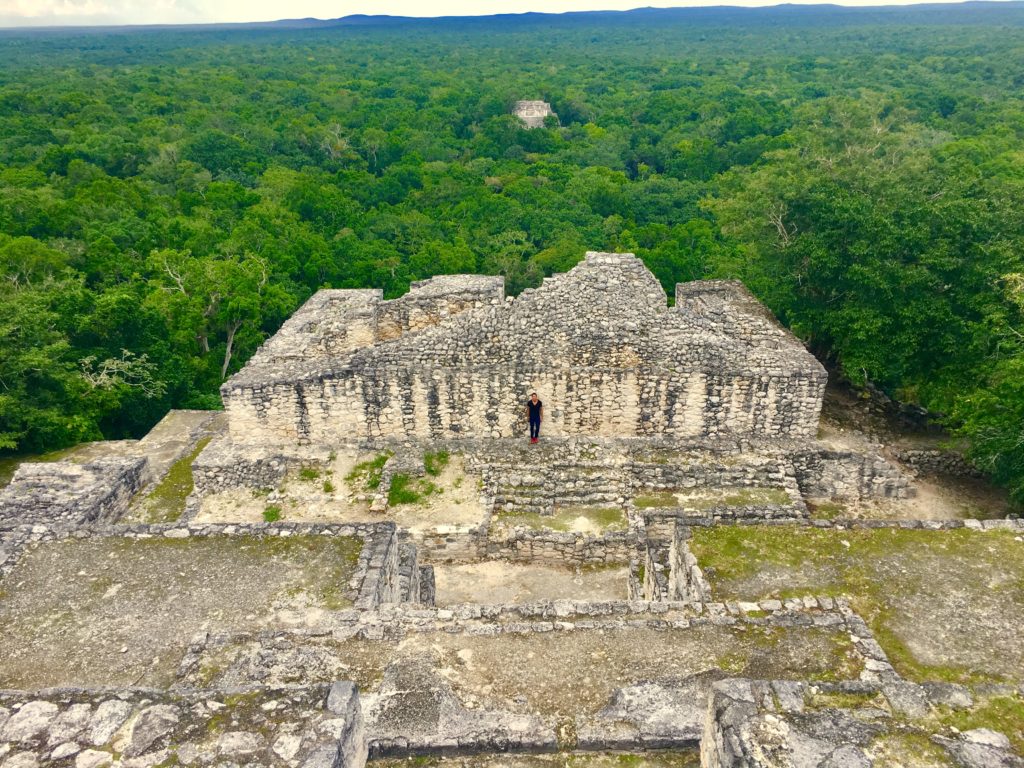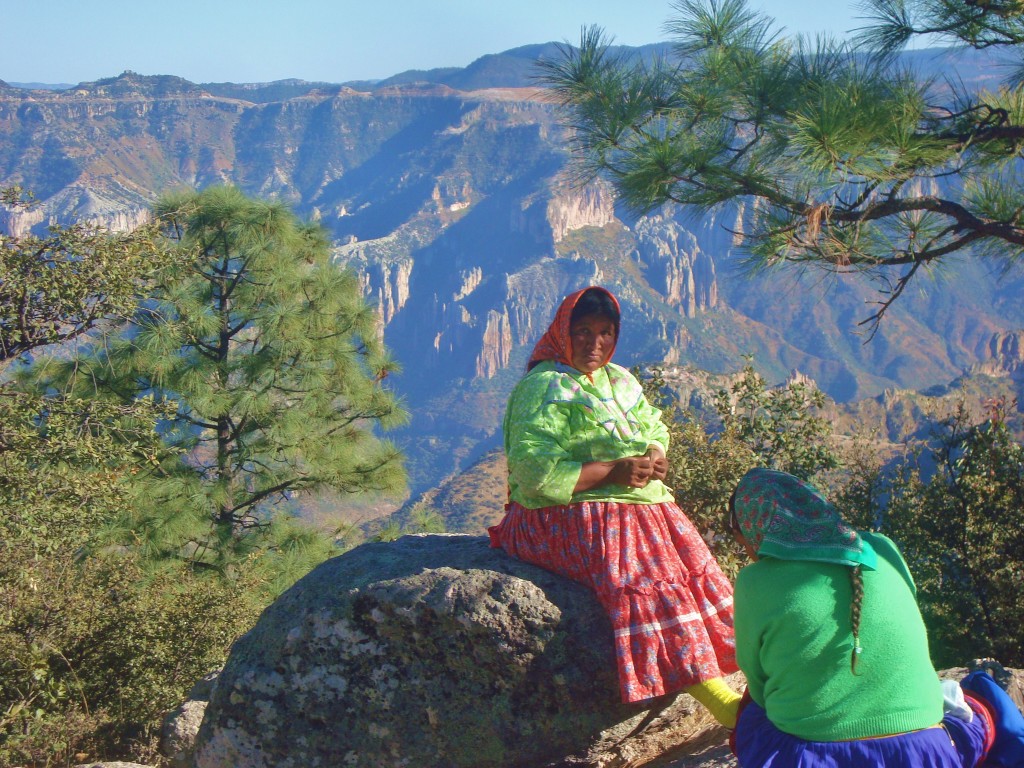
What is the Mayan Train Project?
The Tren Maya (as it is called in Spanish) is a 1500 km (932 mile) tourist train that would connect the popular beaches of the Riviera Maya to towns, archaeological sites and many tourist destinations in the Yucatan Peninsula and beyond. There will be 15 or 16 stations along the route. The project was proposed to bring jobs, development, infrastructure, and to draw tourism into the Yucatan Peninsula and nearby states. The Mayan Train will cost about 7.4 billion USD and it is estimated to take 4 years to build. Although sections of the route can be opened when finished.
What sounds like an exciting way to tour the culturally rich area, also has its doubters as to the possible environmental damage among some of the controversial topics. Lets delve deeper into the details of this project.

What is the status of this project?
We just took a trip on the Tren Maya and have an update for you. In this article we have more information about taking the Tren Maya and what it is like.
Where is it proposed to go?
The basic route is a loop around the Yucatan Peninsula of Mexico with possible connections to Tabasco and Chiapas States. There are three zones of the Mayan Train. They would be the Caribbean route, Gulf route and the Jungle route. The exact route and what cities and towns it will connect, have been in changing over time, with many different proposals. Some areas would see a boom from a station and other areas have to factor in environmental concerns as well as how a train would affect local transportation companies.
The Caribbean route would connect Cancun to the southern end of Quintana Roo State. Some of the stops would include Puerto Morelos, Playa Del Carmen, Tulum, and Bacalar. The Gulf route would connect the Cancun area to Merida, stopping at the ruins of Chichen Itza and then passing south toward Campeche. The Jungle route would connect the southern part of Quintana Roo State to southern Campeche State with a notable stop near the Calakmul Mayan ruins site.

What are both sides of the arguments for and against it?
Like all major projects, there is controversy and many sides. Here are two sides of the argument, for and against the Mayan Train.
What do supporters say about Tren Maya project?
- This would be a stimulus to the local economies and tourism infrastructure of the country.
- It has the potential to be a boom in tourism for the rest of the peninsula and southeast of Mexico.
- It also can lead to the development of some impoverished areas.
- More local jobs can be created. It is estimates that 80,000 jobs overall will be created in 2020 and 150,000 jobs in 2021.
- The Tren Maya uses preexisting tracks where possible. About 30% of the proposed route has tracks already.
- Environmental impact studies have been done, although not in its entirety.
- Some locals favor the project, saying livelihoods are more important than preserving every part of nature.
What those say that are opposed to the Mayan Train
- The main objection is the possible environmental impact of the project. Some of the areas where the tracks would need to be laid are natural reserves and could contaminate underwater aquifers.
- Environmental impact studies have not been done for the entirety of the project. Supporters say this is not necessary since about 30% of the project will use preexisting tracks.
- Construction around local stops in environmentally sensitive areas will create more demand on local water supply, expand towns into the jungle and create more trash.
- Even though some part of the route has preexisting tracks, they will still need to be widened.
- Since most land is owned by the local communities, people are afraid that land will be turned over or sold to private entities. Also, people feel the payment for some of the lands being used for the project is not sufficient.
- People think the beneficiaries of the Mayan Train project will be the financiers and large investors, leaving locals only to benefit minimally from the project.
Will this project be a boom or bust?
The Tren Maya project has been on the drawing boards for years with its proposal to inject stimulus into the southeast region of Mexico. Not only is it proposing to bring jobs, tourism, but also economic activity to an area of Mexico that has not seen much development. Of course, this is all based on if this project get built, will it be the boom it is proposed to be?
Build it and they will come?
This is not likely, sad to say. It will be built, and some will come. It is, however, likely it will be used for the currently popular routes. Just because there is a new train line that connects incredible locations with a scenic backdrop in-between does not mean people will drop everything and hop on board. Why do we say this? Because Mexico already has one of the most stunning passenger rail journeys for tourists. It is called El Chepe and traverses between Los Mochis and Chihuahua covers 673 km (418 miles). The most stunning thing about this rail journey are the views of Copper Canyon. The Copper Canyon consists of several canyons, making it larger and deeper than the Grand Canyon in the United States. As exciting as this rail journey is (and I can testify to this) very few people can say they knew about it, let alone say they have taken this train in Mexico.
People want what they want when they come to Mexico. Of the some 20 million people that land in Cancun International Airport each year, about 85% of them never leave the Riviera Maya and Cancun area. Tourists know this area for its turquoise water and great beaches. Tacking on a multi-day cultural tour of the peninsula will be a hard sell to many.

Will it draw tourist away from the beaches?
The most likely use of the Tren Maya will be trips to Chichen Itza. This is the most popular day trip and Mayan ruins to visit in the entire peninsula, attracting thousands of people daily. The bus trip/tour is a long 3 hours each way. This means that a comfortable train ride will be a more attractive option for many. This however will still offer tour providers options to sell tours. Pick-up and drop off from hotels, transport from the train station to the ruins, guides, meals and side tours from the ruins will all be options to package together something to sell, just swapping the bus expenses for the tickets on the train.
The second most popular route will be the Caribbean route. The tourist will find it fairly easy to go up and down the Riviera Maya with the train. It will also make Bacalar a more popular destination. Bacalar is a little over 3 hours’ drive from Playa Del Carmen for example. This makes it a longer drive than what most people want, and the train can provide a more comfortable ride.
The rest of the train route will have a much smaller market. Older tourists who like a slower way of travel and a comfortable way to see the Yucatan Peninsula will be one market. Another will be more adventurous people looking to skip the bus and take the new train, perhaps mixing it up between bus and train segments. Other than that, this will minimally help draw the millions of tourists away from the beach.
Will locals take the Tren Maya?
Most likely all routes will cost more that pre-exiting bus tickets between the same locations. Most residents are pretty cost conscience and will not move up a class and pay more. Many people that go long distance between Quintana Roo and Chiapas do so to visit family. Even though flights save a lot of time and are somewhat close in price, bus travel remains strong. One of the reasons is the luggage restrictions that airlines have, and people would rather save a few dollars than fly. All of this means that locals will not be a good source of revenue for the train unless prices can be competitive.
Will this bring jobs and prosperity to locals?
If we look at the other tourist train that we mentioned earlier, did the El Chepe train bring jobs and prosperity to locals? It is fair to say that a limited number of direct jobs were created, and it did inject the local economy to a certain extent. The rail line did bring tourism to an area where at the time, did not even have roads connecting it. It is interesting to note that all of the Tren Maya route has roads and is accessible now by car or bus. Even with such access, not that many people visit these places. Hopefully, through good promotion and packages that put things together for tourist, this will bring jobs for locals and give them some prosperity. Does this mean the Mayan Train will be a boom for the southeast of Mexico? We feel it will land somewhere in-between.
So, what will happen to the Mayan Train if it is completed?
It really is up to all of us what happens. Nonlocals don’t really get a say in the development stage, but they do when it comes to the use. Will the Mayan Train turn into a gateway for exploring and preserving the culture of Mexico or will it be its demise? Will people flock to large tour companies and corporate hotels along the route funneling money away from the locals? Or will people seek out interesting local places to stay, buy direct from crafts people and be a boon to locals in the economy? As tourists, we have the spending power and decisions to affect how development is steered.
The Mayan Train gives opportunity to many, but what opportunity comes depends on tourists.
What are your thoughts on the Mayan Train? Let us know in the comments below. We would love to hear from you.
See our article with updated information about the construction of the Mayan Train and how it is affecting transportation and development now.
When will the Tren Maya open for customers? See our article here for the opening times for each route.
If you want to see what some of the stations will look like as well as the train, we have photos here.



I am not in favour of it, not worth the environmental impacts. As a tourist I would not use it.
If the train reduces police stops for shake downs, and makes it safer, I’m all for it.
Charge the tourists more than locals, they do that now with all the attractions .
I love the idea. Moving freight by train is so much better for the environment. … and 6 million? Surly that’s a misprint.
Most hotels cost more than that..
The train will destroy the environment and destroy the culture of the Mayan people. One of the draws of tourists to the rural areas is to learn about the culture of the Mayans. This project will take away the land from the Mayan people with little compensation.
Absolute nonsense that the environment will be destroyed.. sorry Alan, yours is a bandwagon view that you think is cool & right on but shows that you simply don’t have the slightest understanding.
A mile is longer than a kilometer. And 6 million USD cost? Might want to double check that. The b is two letters left of the m on most keyboards.
Great news. Cancun airport/city and PDC traffic is getting untenable and in order to help this, viable transportation alternatives must be available. Bigger roads and highways DO NOT WORK.
We will agree with you because there is too much emphasis on cars. It is already hard to get around Cancun because of all the 6 lane roads and no sidwalks.